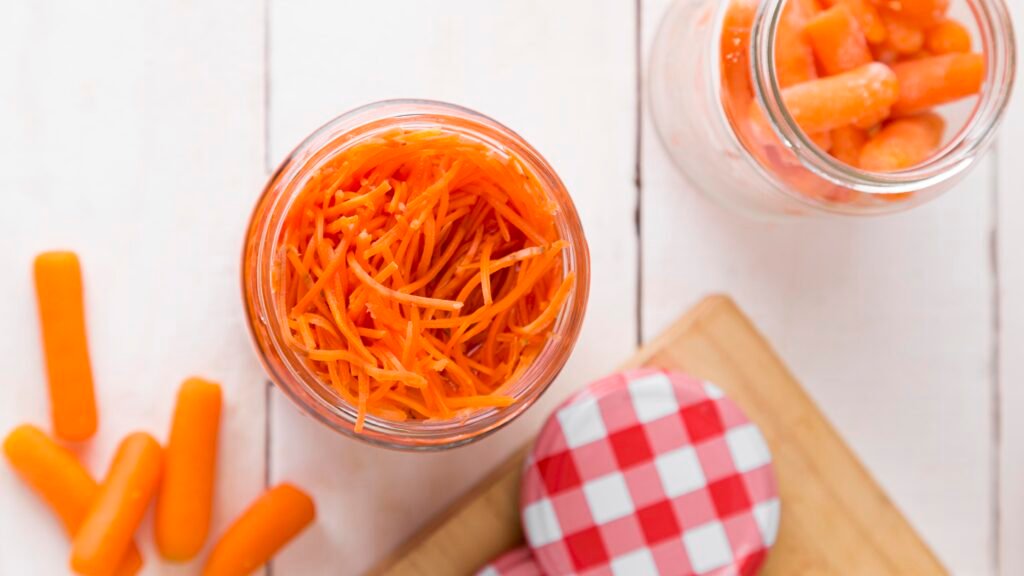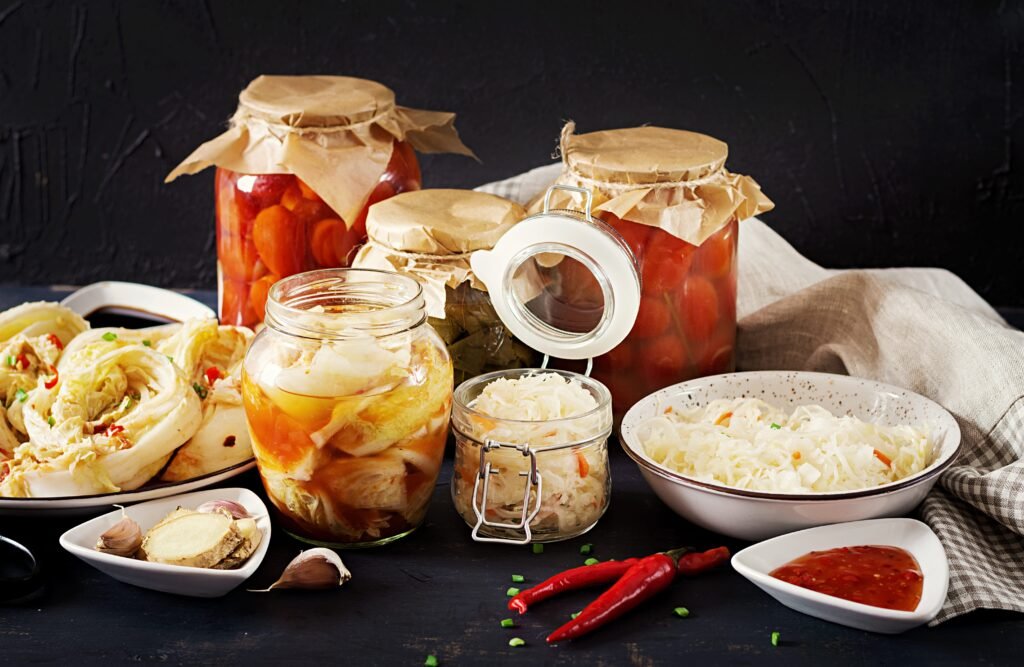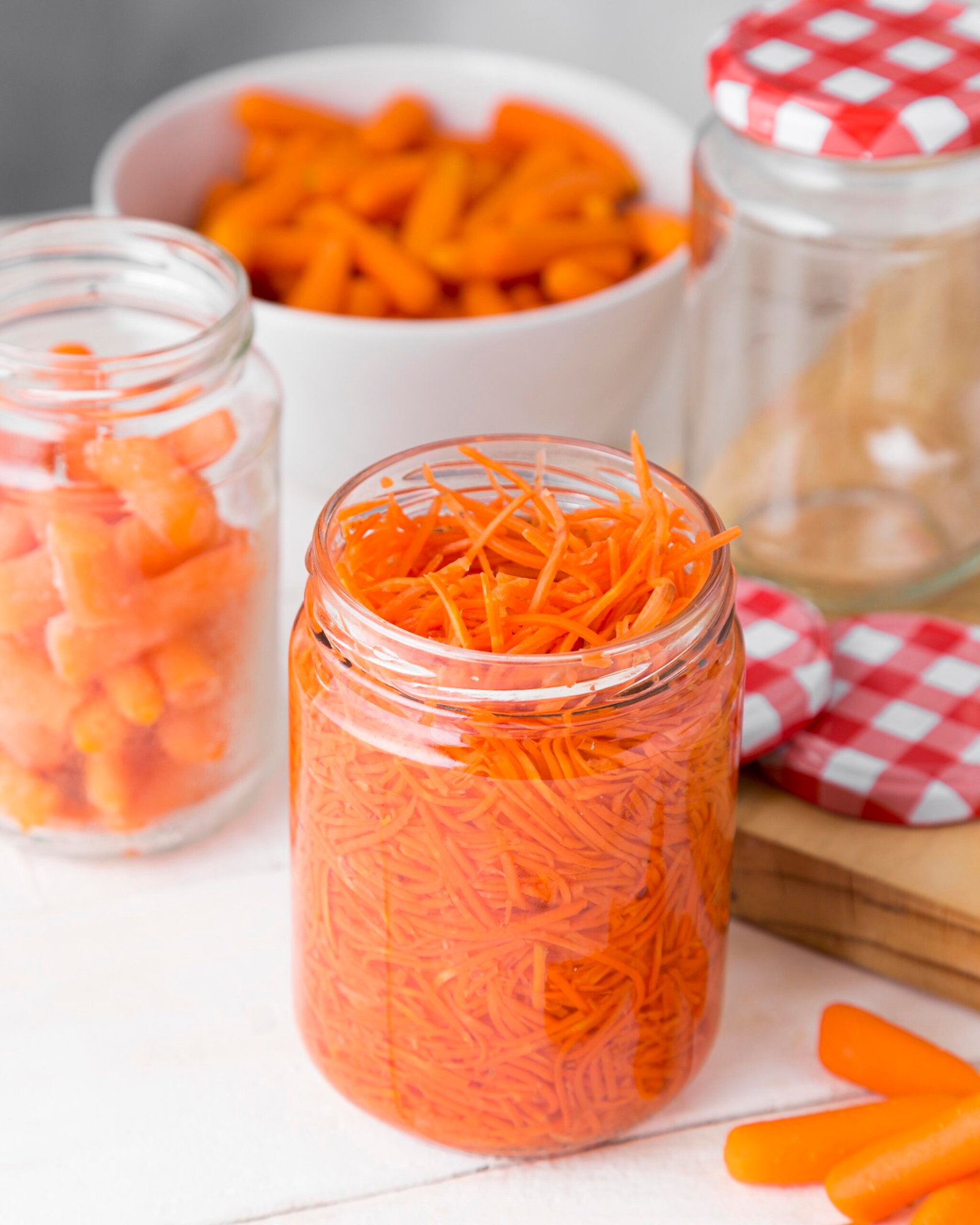Imagine biting into a crisp, tangy carrot that crackles with life—each mouthful bursting with vibrant flavor and gut-loving probiotics. Fermenting carrots at home transforms humble root vegetables into a zesty, nutrient-packed superstar you’ll reach for again and again. Whether you’re a seasoned fermenter or diving into your very first jar, you’re about to discover how unbelievably simple—and deeply rewarding—it is to create your own crunchy probiotic snack.
In just three straightforward steps, you’ll harness the power of natural lacto-fermentation to elevate ordinary carrots into a gourmet delight. No fancy equipment. No obscure ingredients. Just fresh carrots, pure salt, clean water, and a bit of patience. Ready to unlock the secret of how to ferment carrots like a pro—and enjoy a lifetime supply of crunchy, tangy goodness?
Let’s get started! Grab your favorite mason jar, and let’s transform your kitchen into a fermentation lab. Scroll down to master the only three steps you need—and join the ranks of home fermenters who can’t get enough of these probiotic-packed, flavor-exploding carrots. Ready to taste the magic? Dive in below!
Table of Contents
Why Ferment Carrots?

Fermenting carrots unlocks a host of benefits:
- Probiotic Powerhouse: Naturally cultured carrots teem with beneficial bacteria to support gut health.
- Enhanced Flavor: Tangy, slightly sweet, and delightfully crisp—fermented carrots elevate salads, tacos, or a simple snack.
- Longer Shelf Life: Enjoy carrots for months without spoilage.
- Nutrient Boost: Fermentation can increase the bioavailability of vitamins and minerals.
Whether you’re new to fermentation or looking for a quick project, carrot fermentation is incredibly accessible. By learning how to ferment carrots, you’re investing in your health and culinary creativity.
My First Fermentation Adventure
I’ll never forget my first batch of fermented carrots. It was a rainy Sunday afternoon, and I was craving something crunchy and zesty. Armed with a mason jar, a handful of kitchen salt, and a bundle of organic carrots, I embarked on my experiment. Three days later, I popped the lid, took my very first taste, and was hooked on how long to ferment carrots and the endless possibilities that lay ahead. That sense of pride—knowing I created a living, probiotic snack—instilled a lifelong passion for fermentation.
Science Behind Lacto-Fermentation

At its core, lacto-fermentation is simple: salt and time. Here’s what happens:
- Osmosis & Brine Creation: Salt draws water out of carrot cells, creating a natural brine that inhibits spoilage bacteria.
- Lactic Acid Bacteria (LAB) Thrive: Beneficial LAB—present on the carrots’ surface—multiply in the brine, converting sugars into lactic acid.
- Flavor & Preservation: The lactic acid lowers pH, preserving the carrots and adding tangy complexity.
You don’t need a starter culture; your carrots bring the right microbes. Learning how to ferment carrots is essentially harnessing nature’s own preservation method.
Essential Equipment & Ingredients
| Item | Why You Need It |
|---|---|
| Wide-mouth mason jar (1 L+) | Provides enough space for carrots and brine |
| Airlock lid or loose lid | Allows gases to escape while protecting contents |
| Non-iodized salt (e.g., sea salt) | Keeps fermentation on track without off-flavors |
| Filtered water | Ensures no chlorine inhibits bacterial growth |
| Fresh carrots (organic preferred) | The star ingredient—choose crisp, blemish-free roots |
| Optional: spices/herbs | For flavor variations (garlic, dill, peppercorns) |
Pro tip: If your tap water is chlorinated, boil and cool it before use to ensure a thriving ferment.
Step-by-Step Guide to Ferment Carrots in 3 Steps
Step 1: Prepare Your Carrots & Brine
- Wash & Trim
- Rinse carrots thoroughly under cool water to remove dirt.
- Trim the tops and peel if desired (peeling is optional—I love the rustic look of unpeeled carrots!).
- Slice or Shred
- Cut into sticks, coins, or ribbons—choose your preferred shape.
- Make the Brine
- Dissolve 1 tablespoon of non-iodized salt per 2 cups of filtered water.
- Stir until completely dissolved.
Step 2: Submerge & Seal
- Pack the Jar
- Tightly pack carrot pieces into the mason jar, leaving about 2 inches of headspace.
- Pour Brine
- Pour the brine over the carrots until fully submerged.
- Weigh Down
- Use a fermentation weight or a clean oak leaf to keep carrots under the brine.
- Seal
- Attach an airlock lid or screw the regular lid on loosely to allow gases to escape.
Ensuring your carrots stay submerged is crucial to prevent mold and ensure a safe ferment.
Step 3: Wait & Taste
- Fermentation Time
- Store the jar at 65–72°F (18–22°C)—out of direct sunlight.
- Begin tasting after 3 days—the ultimate answer to “how long to ferment carrots” depends on your taste preference.
- Monitor & Burp
- If using a regular lid, open daily to release gases (“burping”).
- Finalizing
- Once you achieve the desired tang (anywhere from 5–10 days), tighten the lid and move to the refrigerator.
Remember, cooler temps slow fermentation. If your kitchen is warm, check earlier; if cool, allow a few more days.
Key Tips for Success
- Cleanliness Is Key: Ensure all equipment is spotless to avoid unwanted microbes.
- Salt Precision: Too little salt invites spoilage; too much prolongs fermentation. Stick to 2% brine (2 g salt per 100 g water) for reliable results.
- Consistent Temperature: Ferments are happiest around room temperature.
- Don’t Panic: Bubbles, cloudiness, and a yeasty smell are normal. Avoid any foul, putrid odors.
Flavor Variations & Add-Ins
One of the greatest joys of fermenting carrots is how easily you can customize them to match your mood, meal, or palate. Below are a dozen inspired combinations—plus tips on balance and technique—to help you create signature jars that go far beyond plain salted carrots.
1. Classic Garlic & Dill
- Ingredients: 2–3 peeled garlic cloves, a handful of fresh dill sprigs
- Why it works: The savory warmth of garlic complements the bright, herbal notes of dill, evoking a refrigerator pickle vibe that pairs beautifully with sandwiches, salads, and roasted meats.
2. Spicy Ginger & Turmeric
- Ingredients: 1-inch knob fresh ginger (thinly sliced), ½–1 tsp ground turmeric or ½-inch fresh turmeric (sliced)
- Why it works: Anti-inflammatory turmeric and zippy ginger add an earthy heat and sunshine-yellow hue. Perfect for serving alongside curries or stirring into grain bowls for an extra digestive boost.
3. Smoky Paprika & Cumin
- Ingredients: 1 tsp smoked paprika, ½ tsp cumin seeds
- Why it works: Smoked paprika infuses a campfire aroma, while cumin seeds bring warm, nutty depth. These carrots are irresistible on tacos, alongside grilled vegetables, or mixed into hummus.
4. Lemon & Black Peppercorn
- Ingredients: Zest of one lemon (use a peeler for broad strips), 1 tsp whole black peppercorns
- Why it works: The bright citrus oils in the lemon zest elevate the ferment’s acidity, while peppercorns add a subtle, lingering heat—ideal as a zesty snack or chopped into chicken salad.
5. Indian-Style Mustard & Curry Leaves
- Ingredients: 1 tsp yellow mustard seeds (lightly crushed), 6–8 fresh curry leaves
- Why it works: Mustard seeds pop in your mouth, releasing pungent, tangy oil; curry leaves add a floral, citrusy note. Serve over rice dishes or in dhal for an authentic touch.
6. Korean Gochugaru & Sesame
- Ingredients: 1–2 tsp Korean red pepper flakes (gochugaru), 1 tbsp toasted sesame seeds
- Why it works: Gochugaru brings gentle heat and vibrant color; sesame seeds contribute toasty richness. Fantastic in bibimbap bowls or as a side to Korean BBQ.
7. Herbes de Provence & Garlic Scapes
- Ingredients: 1 tsp Herbes de Provence blend, 2–3 sliced garlic scapes
- Why it works: This French-inspired mix—lavender, thyme, rosemary—layers floral complexity over the ferment, while garlic scapes add a mellow allium sweetness. Elevate charcuterie boards or goat cheese crostini.
8. Citrus & Chili Flakes
- Ingredients: Strips of orange or grapefruit peel, ½–1 tsp red chili flakes
- Why it works: Sweet citrus oils dance with a slow-building spice, creating an invigorating bite. Chop into salsas or serve alongside seafood for a dynamic flavor contrast.
9. Thai-Style Lemongrass & Thai Basil
- Ingredients: 1 stalk lemongrass (bruised and cut into pieces), a few fresh Thai basil leaves
- Why it works: Lemongrass lends bright, lemony notes; Thai basil adds peppery, anise-like sweetness. These carrots are a stellar garnish for spring rolls or noodle soups.
10. Mediterranean Olive & Oregano
- Ingredients: 4–6 pitted Kalamata olives (halved), 1 tsp dried oregano
- Why it works: The briny olives infuse the brine with umami saltiness, while oregano offers that classic Mediterranean herbal fragrance—wonderful in pasta salads or atop grilled halloumi.
Tips for Using Add-Ins
- Balance Intensity: Strong flavors (e.g., garlic, turmeric, mustard seeds) should be used sparingly—start with half the recommended amount and adjust next time.
- Fresh vs. Dried: Fresh herbs add brighter, more nuanced aroma; dried spices contribute deeper, more concentrated flavor. Feel free to swap based on availability.
- Layering: For multidimensional ferments, combine one fresh element (like herb sprigs) with one spice (like seeds or flakes).
- Placement: Tuck heavier items (olives, citrus peels) near the bottom of the jar so they stay submerged. Light herbs and blossoms can be packed between or on top of carrot layers.
- Experiment in Small Batches: Try new combinations in 1–2 cup jars before committing to a large batch—this way you can fine-tune ratios and discover your favorite signature ferment.
With these variations and guidelines, you’ll never serve a boring jar of fermented carrots again. Mix, match, and make each batch uniquely yours!
How Long to Ferment Carrots?
Determining how long to ferment carrots isn’t one-size-fits-all—it depends on temperature, brine strength, and your personal taste. Here’s a more detailed roadmap to help you hit the perfect balance of tang and crunch:
| Fermentation Stage | Timeframe (at 70°F/21°C) | Texture & Flavor Profile |
|---|---|---|
| Lightly Tangy & Crisp | 3–5 days | Bright orange, super crunchy, with a gentle acid bite—ideal if you’re new to how to ferment carrots or want a mild pickle-like snack. |
| Balanced Tang & Bite | 5–7 days | A noticeable sourness without overpowering funk; carrots soften just enough to yield a satisfying snap. My go-to stage for everyday probiotic snacking. |
| Deeply Sour & Softened | 7–10 days | Sharp lactic tang builds, and carrots become more flexible—perfect for slaws, dressings, or as a bold charcuterie board accent. |
| Bold & Intensely Fermented | 10–14+ days | Translucent, tender, and profoundly sour—this kraut-like depth takes fermented carrots to another level, great for adventurous palates and gut boosts. |
Factors That Alter Timing
- Temperature
- Warmer (75–80°F/24–27°C): Speeds things up by 1–2 days per stage.
- Cooler (60–65°F/16–18°C): Adds 1–2 days per stage; slows bacterial activity.
- Jar Size & Packing
- Tightly packed carrots, especially in large jars, may need extra time for the brine to penetrate fully.
- Salt Concentration
- Standard 2% brine is a reliable baseline.
- Less salt (<2%) quickens fermentation but risks spoilage; more salt (>2.5%) slows it down.
- Carrot Freshness & Sugar Content
- Sweeter, fresher carrots feed the bacteria more readily, shaving a day or so off the process.
Tips for Nailing Your Ferment
- Taste Regularly: Starting on day 3, sample carrots every 1–2 days. Use a clean utensil and note how the flavor develops at different depths.
- Keep Records: Jot down the date, room temperature, and your flavor impressions. After a couple of batches, you’ll know exactly when to harvest your signature crunch and tang.
- Adjust & Enjoy: Once you’ve dialed in your ideal timing, stick to it—or tweak one variable at a time (temperature, salt, or cut size) to explore new flavor nuances.
With this guide to how long to ferment carrots, you can confidently ferment small or large batches, knowing exactly when to pull that perfect jar of probiotic-packed, flavor-bomb carrots from the counter. Happy fermenting!
Storing & Shelf Life
- Refrigerate: After moving to the fridge, ferments slow dramatically.
- Enjoy Within: Up to 4–6 months—flavor will continue to evolve but remains safe and delicious.
- Watch for Off-Notes: If you see fuzzy mold or smell rotten, discard and try again.
Serving Suggestions & Recipes
- Salad Topper: Chop and sprinkle over leafy greens with goat cheese.
- Sandwich Crunch: Adds texture to banh mi or veggie wraps.
- Charcuterie Boards: Alongside cheeses, olives, and cured meats.
- Fermented Carrot Slaw: Mix with shredded cabbage, a splash of apple cider vinegar, and olive oil for a zesty slaw.
Health Benefits of Fermented Carrots

Fermented carrots aren’t just a crunchy, tangy treat—they’re a powerhouse of nutrition and wellness support. Here’s a closer look at the key health benefits you gain with every bite:
- Rich Source of Probiotics
- During lacto-fermentation, naturally occurring Lactobacillus and other beneficial bacteria flourish in the brine. These probiotics help:
- Balance gut flora, promoting healthy digestion and regularity.
- Inhibit harmful pathogens, supporting immune defenses in the digestive tract.
- Produce B-vitamins and short-chain fatty acids that nourish intestinal cells.
- During lacto-fermentation, naturally occurring Lactobacillus and other beneficial bacteria flourish in the brine. These probiotics help:
- Improved Nutrient Bioavailability
- Fermentation breaks down anti-nutrients like phytic acid, unlocking greater access to:
- Beta-carotene, the precursor to vitamin A, crucial for vision and skin health.
- Vitamin K, important for bone metabolism and blood clotting.
- Minerals such as potassium and magnesium, supporting heart function and muscle health.
- Fermentation breaks down anti-nutrients like phytic acid, unlocking greater access to:
- Natural Detoxification
- Probiotic activity enhances the liver’s detox pathways by reducing gut permeability.
- Short-chain fatty acids (e.g., butyrate) generated during fermentation help:
- Strengthen the gut barrier, preventing toxins from leaching into the bloodstream.
- Support colonocyte health, aiding in waste elimination and reducing inflammation.
- Immune System Support
- Around 70% of the body’s immune cells reside in the gut. A thriving microbiome:
- Stimulates antibody production.
- Regulates inflammatory responses, lowering the risk of chronic conditions.
- Helps modulate allergic reactions and may reduce incidence of common colds.
- Around 70% of the body’s immune cells reside in the gut. A thriving microbiome:
- Antioxidant and Anti-Inflammatory Effects
- Carrots are already rich in antioxidants like beta-carotene and polyacetylenes; fermentation can:
- Increase the concentration of free-radical-scavenging compounds.
- Complement turmeric or ginger add-ins to boost anti-inflammatory activity in the gut.
- Carrots are already rich in antioxidants like beta-carotene and polyacetylenes; fermentation can:
- Supports Metabolic Health
- Regular consumption of fermented foods has been linked to improved insulin sensitivity and a healthier lipid profile.
- The synergistic effect of dietary fiber, probiotics, and bioavailable nutrients can help stabilize blood sugar and support weight management.
- Mood and Cognitive Benefits
- The gut-brain axis means a happy gut can translate to better mental health:
- Probiotics produce neurotransmitters like GABA and serotonin precursors.
- A balanced microbiome can reduce stress-induced inflammation and support clearer thinking.
- The gut-brain axis means a happy gut can translate to better mental health:
Final Thoughts
Fermenting carrots at home is not only a gateway into the transformative world of lacto-fermentation but also a rewarding journey in self-sufficiency and flavor exploration. Armed with just carrots, salt, water, and a bit of patience, you can create crunchy, tangy delights that fuel gut health, preserve produce, and enliven every meal.
So grab that mason jar, start how to ferment carrots with our three simple steps, and savor the magic of living foods in your own kitchen. Happy fermenting!
FAQs
Q .What salt is best for fermenting carrots?
Use non-iodized salt—such as sea salt, kosher salt, or pickling salt—to avoid anti-caking agents or iodine that can inhibit fermentation. Aim for a 2% brine by weight (2 g salt per 100 g water).
Q. Can I ferment carrots without a starter culture?
Yes! Carrots naturally harbor Lactobacillus bacteria on their skins. Simply use a proper salt-to-water ratio and clean equipment to let wild cultures do the work.
Q. Do fermented carrots need to be refrigerated?
Once your carrots reach your desired tang (usually 5–10 days), seal the jar tightly and move it to the refrigerator. Cooling slows fermentation and preserves flavor for 4–6 months.
Q. Why are my fermented carrots mushy?
Mushiness can result from:
- Fermenting at too warm a temperature (>75°F/24°C)
- Over-fermenting beyond 10–14 days
- Using overly ripe or very large carrots
To maintain crunch, use fresh carrots, ferment cooler, and taste early.
Q. How can I speed up fermentation?
- Increase ambient temperature slightly (but stay under 80°F/27°C).
- Shred or slice carrots smaller for faster brine penetration.
- Use a clean, smaller jar for higher brine-to-carrot ratio.
Q. Can I reuse carrot brine to start a new batch?
While tempting, it’s safer to start fresh brine each time. Used brine may harbor unwanted yeasts or off-flavor bacteria.
Q. Is it safe to eat the fermenting liquid?
Absolutely! The brine is rich in electrolytes and probiotics—sip it like a tangy tonic or add it to salad dressings and soups.
Q. What flavors pair best with fermented carrots?
Popular add-ins include:
- Garlic & dill for a pickle-style crunch
- Ginger & turmeric for warm, anti-inflammatory benefits
- Chili flakes & sesame for spicy, Asian-inspired notes
Q. Can I ferment shredded carrots instead of sticks?
Yes—shredded carrots ferment faster (often within 2–4 days) due to increased surface area, but require closer monitoring to avoid over-tanginess.
Q. How do I prevent mold on fermented carrots?
- Ensure all carrots remain fully submerged under brine (use a weight).
- Keep your jar and utensils spotlessly clean.
- Burp airlock or jar lid daily to release CO₂.
Q. What’s the best way to flavor carrot ferment for beginners?
Start simple with garlic & dill or lemon zest & peppercorns—both use pantry staples and reliably delicious results.
